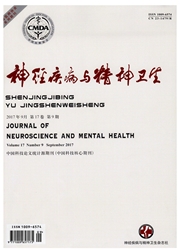

 中文摘要:
中文摘要:
目的 比较路易体痴呆(DLB)和帕金森病痴呆(PDD)患者神经心理学特征的差异.方法 采用简易精神状态检查量表(Mini-mental State Examination,MMSE)、画钟测验(Clock-drawing Test,CDT)、神经精神问卷(Neuropsychiatric Inventory,NPI)、日常活动能力量表(Activities of Daily Living Scale,ADL)、汉密尔顿抑郁量表(Hamilton Depression Scale,HAMD)17项版本、临床痴呆评定量表(Clinical Dementia Rate,CDR)评估20例DLB患者和56例PDD患者的认知功能,并比较不同痴呆阶段的两组患者神经心理学差异.结果 60%的DLB患者存在症状的波动,多于PDD患者(19.6%)(P=0.001).中重度痴呆阶段,DLB组NPI评分高于PDD组(P〈0.05).轻度痴呆阶段,PDD患者在CDR的家庭生活和个人业余爱好域评分高于DLB患者(P=0.039).中重度痴呆阶段,DLB组记忆力(P=0.018)和定向力评分(P=0.010)以及CDR总体得分(P=0.028)高于PDD组.结论 临床工作中结合病史并对痴呆患者进行全面的神经心理学检查有助于鉴别DLB和PDD.
 英文摘要:
英文摘要:
Objective To compare the differences of neuropsychological profile between patients with dementia with lewy bodies(DLB) and Parkinson disease dementia(PDD).Methods A total of 20 DLB patients and 56 PDD patients were recruited in this study. Mini-mental State Examination(MMSE), Clock-draw-ing Test(CDT), Neuropsychiatric Inventory(NPI), Activities of Daily Living Scale(ADL), Hamilton Depression Scale(HAMD) and Clinical Dementia Rate(CDR) were used to evaluate the cognitive function.Results A total of 60% of DLB patients had fluctuant symptoms, significantly higher than PDD patients(19.6%,P=0.001). In the moderate and severe stage of dementia, the NPI scores of DLB group were significantly higher than that of PDD group(P〈0.05). In the mild dementia stage, the scores of the family life and personal hobby domain in CDR were higher in PDD patients than that in DLB patients(P=0.039). In the moderate and severe stage, the memory score(P=0.018), orientation score(P=0.010) and overall CDR score(P=0.028) in DLB group were higher than that in PDD group.Conclusions Comprehensive neuropsychological tests combined with clinical history can help identify DLB and PDD in dementia patients.
 同期刊论文项目
同期刊论文项目
 同项目期刊论文
同项目期刊论文
 期刊信息
期刊信息
